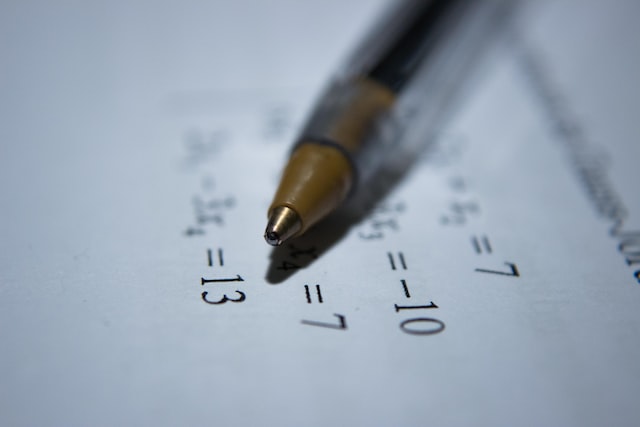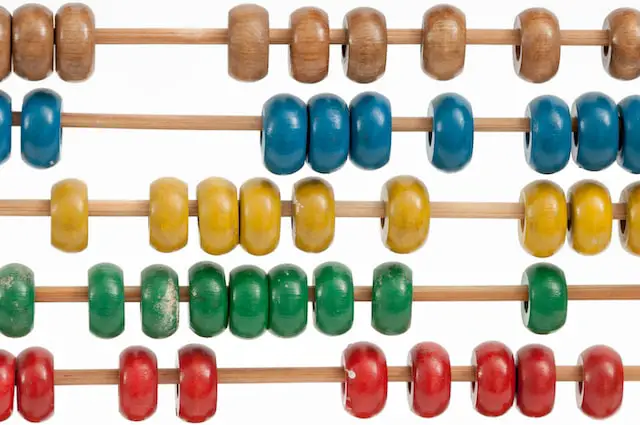The abacus is an ancient calculation tool using beads or stones on rods arranged in a frame, Vedic maths relies on word-based formulae to perform complex calculations quickly and accurately. Both approaches have been used throughout history to calculate figures large and small.
What is abacus?
(Photo by GVZ 42 on Unsplash )

An abacus is a manual calculating tool that has been used for centuries to perform arithmetic operations. It is a rectangular frame with parallel rods or wires that run along its length, with beads or counters sliding freely along the rods.
The abacus has been used in many different cultures and time periods, and there are many different types of abaci. The most common type is the Chinese abacus, which has two beads on the top row and five beads on the bottom row of each rod. The beads are moved up and down the rods to perform calculations.
The abacus is used for addition, subtraction, multiplication, and division. It is particularly useful for teaching children mathematical concepts as it allows them to visualize the calculations and understand the principles behind them.
Although the use of the abacus has declined with the rise of electronic calculators, it is still used in some parts of the world, particularly in Asia, and is also considered a valuable educational tool.
What is Vedic math’s?
(Photo by Antoine Dautry on Unsplash )

Vedic Mathematics is a system of mathematics that originated in ancient India around 1500-800 BCE. It is based on the Vedas, which are a collection of sacred texts in Hinduism.
The Vedic system of mathematics is known for its simplicity and efficiency, as it uses a set of simple rules and principles to perform complex calculations. These principles are based on the concept of “sutras,” which are short, aphoristic statements that provide a quick and easy way to solve mathematical problems.
Some of the key features of Vedic mathematics include its emphasis on mental calculation, its use of patterns and symmetry, and its focus on finding alternative methods for solving problems. It covers various branches of mathematics such as arithmetic, algebra, geometry, trigonometry, calculus, and even higher-level concepts.
The system of Vedic mathematics has gained popularity in recent times, as it is seen as a way to make mathematics more accessible and enjoyable for students. It has been adopted in many schools and universities worldwide, and there are now numerous books and online resources available for those interested in learning more about this ancient system of mathematics.
The difference between abacus and Vedic math’s
Abacus is a physical tool that helps children with counting and math calculations. Vedic math is an ancient system of mathematics that is based on mental calculation.
The main difference between abacus and Vedic math’s is that abacus is a physical tool while Vedic math’s is an mental system. Abacus can be used by people of all ages, but it is most commonly used by children. Vedic math’s, on the other hand, is an mental system that is most commonly used by adults. Abacus requires the use of both hands to count and do mathematical operations. With Vedic math’s, all calculations are done in the mind without the need for any physical tools.
How to use an abacus
Using an abacus is actually quite simple once you know the basics. Each bead has a value, and moving them around to different positions represents different operations. For example, adding two numbers together would involve moving the beads into position so that they correspond to the numbers you are adding, then moving them all towards the center of the frame. Subtraction works in a similar way.
Multiplication and division are a bit more complicated, but can be done by using basic multiplication and division facts along with some clever bead movement. For instance, to multiply 7 by 8, you would first move 8 beads over to represent 8 groups of 7 (56), then add 4 more single beads to get to 64 (the answer).
The abacus is a powerful tool that can be used for simple arithmetic as well as more complex mathematical operations. With a little practice, anyone can learn how to use one!
How to use Vedic math’s
Vedic mathematics is a system of mathematics that offers various techniques and shortcuts to perform arithmetic and algebraic operations. Here are some of the basic techniques used in Vedic mathematics:
Addition and Subtraction:
Addition and subtraction can be performed by using the complementary numbers technique. To add or subtract two numbers, find the difference between each number and a base number that is convenient to work with. Then, add or subtract the differences and adjust the result by adding or subtracting the base number.
Multiplication:
Multiplication can be performed by using the Vertically and Crosswise technique. This technique involves multiplying the vertical and diagonal digits of two numbers and adding the results.
Division:
Division can be performed using the Nikhilam technique. This involves finding a base number that is a power of ten and dividing both the dividend and divisor by this base number. The quotient is then obtained by multiplying the quotient obtained by dividing the dividend by the base with the remainder obtained by dividing the dividend by the base.
Square Roots:
Square roots can be found using the Vedic Duplex technique. This technique involves splitting the number into pairs of digits, finding the largest square less than or equal to the leftmost pair, and then subtracting this square from the leftmost pair. The remainder is then combined with the next pair of digits, and the process is repeated until the square root is obtained.
Which is better abacus or Vedic math’s?
If you are looking for a hands-on approach to learning math, then abacus would be the better choice. You can actually see and touch the beads as you move them around, which helps solidify the concepts in your mind. However, abacus can be slower than Vedic math’s when it comes to doing actual calculations.
If you want a fast and efficient way to do mental math, then Vedic math’s would be the better option. Once you learn the special techniques, you can do calculations much faster in your head than with an abacus. However, Vedic math’s can be harder to learn at first since there is no physical object to help guide you through the concepts.
What is the right age to start with the abacus?
There is no definitive answer to this question as it depends on a number of factors, such as the child’s level of interest and aptitude. Some parents start their children with the abacus as early as 4 or 5 years old, while others wait until 6 or 7 years old. Ultimately, it is up to the parent to decide when their child is ready to start using the abacus.
One reason why some parents choose to wait until their child is a little older before starting with the abacus is because it can be quite challenging for younger children. If a child is not ready for the challenge, they may become frustrated and give up easily. However, if a child shows a keen interest in learning how to use the abacus, then starting at an earlier age may be more beneficial.
There are many benefits to using an abacus for learning math. The most obvious benefit is that it helps to improve mathematical skills. The abacus encourages children to use both sides of their brain when solving problems, which can lead to better long-term problem-solving skills. Additionally, using an abacus can help to improve memory and concentration levels.
The advantages and disadvantages of learning with the abacus
There are many advantages to learning with the abacus, including improved mental math skills, greater concentration and focus, and improved problem-solving skills. However, there are also some disadvantages to using this method of learning, including the need for more practice to master the techniques and the possibility of developing bad habits if not used correctly.
The advantages and disadvantages of learning Vedic Math’s
There are many advantages and disadvantages to learning Vedic Math’s. Some of the advantages include that it can help improve mental arithmetic skills, it can be used to calculate large numbers quickly, and it can help students understand other mathematical concepts more easily. However, some of the disadvantages include that it can be difficult to learn, it may not be useful for all types of calculations, and some people may find it more difficult to use than other methods.
Does abacus increase IQ?
There is no clear consensus on whether or not using an abacus improves IQ scores. Some studies suggest that there is a positive correlation between the two, while other studies are not able to confirm this link. However, there are many different factors that contribute to IQ scores, so it is difficult to isolate the impact of using an abacus. Overall, more research is needed in this area to better understand the relationship between abacus use and IQ scores.
Featured Image By – Photo by Crissy Jarvis on Unsplash








